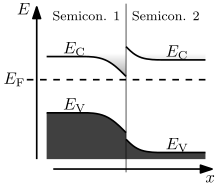



In solid-state physics of semiconductors, a band diagram is a diagram plotting various key electron energy levels (Fermi level and nearby energy band edges) as a function of some spatial dimension, which is often denoted x.[1] These diagrams help to explain the operation of many kinds of semiconductor devices and to visualize how bands change with position (band bending). The bands may be coloured to distinguish level filling.
A band diagram should not be confused with a band structure plot. In both a band diagram and a band structure plot, the vertical axis corresponds to the energy of an electron. The difference is that in a band structure plot the horizontal axis represents the wave vector of an electron in an infinitely large, homogeneous material (a crystal or vacuum), whereas in a band diagram the horizontal axis represents position in space, usually passing through multiple materials.
Because a band diagram shows the changes in the band structure from place to place, the resolution of a band diagram is limited by the Heisenberg uncertainty principle: the band structure relies on momentum, which is only precisely defined for large length scales. For this reason, the band diagram can only accurately depict evolution of band structures over long length scales, and has difficulty in showing the microscopic picture of sharp, atomic scale interfaces between different materials (or between a material and vacuum). Typically, an interface must be depicted as a "black box", though its long-distance effects can be shown in the band diagram as asymptotic band bending.[2]
- ^ "The energy band diagram of the Metal-Oxide-Silicon (MOS) Capacitor". ecee.colorado.edu. Archived from the original on 2020-07-27. Retrieved 2017-11-05.
- ^ "Schottky Barrier Basics". academic.brooklyn.cuny.edu. Retrieved 2017-11-05.